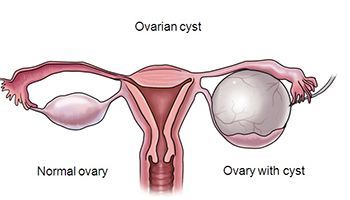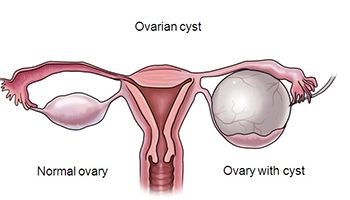Quistes ováricos

Ovarian Cyst

Introduction
Ovarian cysts are a common condition in women during the childbearing years. They result when a cyst forms on the ovary. An ovarian cyst may or may not cause symptoms. The majority of ovarian cysts go away without treatment. In some cases, surgery may be necessary to remove large or ongoing cysts.
Anatomy
The ovaries are two small organs that produce eggs and hormones. The ovaries contain follicles that produce and release an egg each month. Sometimes a follicle does not break open to release the egg or it closes then seals after an egg is released. The follicle keeps growing and forms a cyst. A cyst is a sac-like structure that is filled with fluid or semi-solid material. Cysts that develop during the normal function of your menstrual cycle are termed functional cysts.
Causes
Ovarian cysts can result from the natural function of the menstrual cycle. A functional cyst may form if the follicle does not open to release an egg or if it seals after an egg is released. Ovarian cysts are not the same thing as cancerous ovarian tumors or polycystic ovarian disease. Functional cysts are more common during the childbearing years and rare after menopause. There are two types of functional cysts, follicular cysts and corpus luteum cysts.
A follicular cyst results when the follicle does not release an egg. The fluid in the follicle remains and forms a cyst. Follicular cysts are usually harmless and go away on their own in time.
A corpus luteum cyst develops when a follicle seals after releasing an egg. Fluid builds up in the follicle and forms a cyst. A corpus luteum cyst can grow quite large and become several inches in size. It may rupture and bleed. The fertility drug clomiphene citrate increases the risk of developing a corpus luteum cyst. A corpus luteum cyst does not harm or threaten a pregnancy.
Symptoms
An ovarian cyst may or may not produce symptoms. An ovarian cyst may cause pelvic pain. The pain is usually dull and may be constant or come and go. The pain may spread to your lower back and thighs. Your pain may increase during sexual intercourse, a bowel movement, or at the beginning or end of your menstrual period. You may experience abdominal bloating or swelling. Your periods may change and become longer, shorter, absent, or irregular.
Diagnosis
Your doctor may detect an ovarian cyst while performing a pelvic examination. A doctor may conduct an ultrasound test if an ovarian cyst is suspected. In some cases, a computed tomography (CT) scan or magnetic resonance imaging (MRI) scan may be used to create images of your ovary. Additional tests may be ordered to rule out other conditions with similar symptoms.
Treatment
In most cases, ovarian cysts go away without treatment. Birth control pills may be used to establish regular menstrual cycles and prevent cyst formation. Large ovarian cysts that do not go away without treatment may need to be surgically removed. A laparoscopy may be used to remove an ovarian cyst.
A laparoscopy is a minimally invasive surgical procedure that uses a laparoscope to view the ovary. A laparoscope is a type of endoscope. It consists of a thin tube with a light and viewing instrument. Images from the laparoscope may be sent to a video monitor. The images guide the surgeon during the removal of an ovarian cyst.
Prevention
For women that are not seeking pregnancy, birth control pills may help regulate menstrual cycles and prevent follicle formation.
Am I at Risk
Functional ovarian cysts are more common during the childbearing years, from puberty to menopause. Functional ovarian cysts are rare after menopause. Women that take the fertility drug clomiphene citrate have an increased risk for corpus luteum cysts.
Complications
Large ovarian cysts may twist, rupture, or bleed, causing severe pain. You should seek immediate medical attention if you experience symptoms of shock, which may include passing out, rapid breathing, dizziness/lightheadedness, weakness, and cold or clammy skin.
Ovarian Cysts
An ovarian cyst is a collection of excess fluid in the ovary. The formation of fluid around a developing egg is a normal process in all ovulating women, but sometimes, for reasons doctors do not yet understand, too much fluid is formed. The follicle containing the egg expands, forcing the ovary to expand as well, and this may be experienced as pressure or pain in the pelvic area. On the other hand, some women do not feel the cyst at all, and it may only be discovered during a routine gynecological exam.
The vast majority of ovarian cysts are not cancerous, and most of the time they go away by themselves as the fluid is absorbed back into the body. The formation of new cysts can often be prevented by taking birth control pills.
When do cysts need to be removed?
Rarely, a cyst may not go away and surgery may be needed to remove the cyst.
- One scenario is that the cyst causes the ovary to twist around, cutting the blood flow to the ovary and causing severe pain. This is called ovarian torsion.
- Another reason for surgery is the presence of an epithelial ovarian cyst. During ovulation the ovary releases an egg through a tiny rupture in its lining, or epithelium. Normally this closes and heals quickly without incident. Sometimes, however, a few cells from the epithelium make their way into the divot left by the egg and become trapped there during healing. These cells form a fluid that collects and grows into an epithelial ovarian cyst. Because the cyst is trapped inside the ovary, it must be removed surgically.
- A condition called endometriosis can cause a blood-filled ovarian cyst called an endometrioma that will require surgical removal. This type of cyst is formed from endometrial cells (cells from the inner lining of the uterus) that mistakenly traveled up through the fallopian tube into the ovary and began to grow there. Endometrial cells are programmed to grow and bleed with the monthly cycle, and normally they are shed with the menstrual flow. However, if they become trapped inside an ovary, the blood collects and forms a cyst.
- Some ovarian cancers are cystic, so that persistence or increased growth of a cyst as viewed on a sonogram warrants laparoscopic investigation with removal of the cystic tissue for histologic inspection and diagnosis.
- Cysts which are partially solid or have internal wells as determined by ultrasound may also have to be removed.
Treatment options
Since most ovarian cysts in premenopausal women disappear spontaneously, treatment is seldom required. Women who are prone to developing cysts repeatedly may want to use birth control pills to prevent the growth of new cysts until they are ready to bear children.
For cysts that do need to be removed, minimally invasive laparoscopic surgical techniques can now be used to remove these cysts (cystectomy) while preserving the health of the ovary and promising a quick recovery.
References:
- American College of Obstetricians and Gynecologists. Gynecological Problems: Ovarian Cysts. 2005. www.acog.org/publications/patient_education.pdf/bp075.cfm.
- American Society for Reproductive Medicine. Pelvic Pain: A Guide for Patients. Patient Information Series 1997. www.asrm.org/patients/patientbooklets/pelvicpain.pdf.
- Parker WH. A Gynecologist’s Second Opinion. © 2003; A Plume Book; Published by the Penguin Group, New York, NY.
- Parker W. The case for laparoscopic management of the adnexal mass. Clin Obstet Gynecol. 38:362-69.
Copyright 2020 AAGL. By using this site, you agree to our Terms of Service and Privacy Policy